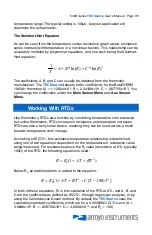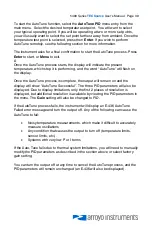
Page 38 · 5400 Series
TECSource
User’s Manual
PID Formula:
dt
d
D
dt
I
P
Output
*
*
*
Where
is the error in the system, expressed as:
= Target - Actual
The controller can calculate ideal PID values using the AutoTune function,
discussed in detail in the next section.
To manually adjust the PID, start by changing the I and D values to zero, and
adjust the P value so that it reaches the set point as quickly as possible without
overshooting the set point an unacceptable amount. Gradually increase the I
value until the set point is achieved without oscillation. In many systems, the D
term is not needed and may be left at zero.
For additional information on PID loop tuning, consult online resources such as
Wikipedia (http://en.wikipedia.org/wiki/PID_controller) or search for terms such
as “Ziegler-Nichols method”, or “PID Loop”.
Using the AutoTune Function
The
TECSource
is capable of automatically determining PID parameters for
most applications. Using a form of the Ziegler-Nichols method, the
TECSource
will step through a process to determine the thermal response of the mount,
which can then be used in a mathematical model to calculate the PID
parameters.
The PID parameters generated by AutoTune are not necessarily the
ideal
PID
parameters, and small improvements may be possible by further refining the
results manually.
Before starting the AutoTune function, it is best to begin from ambient
conditions, either with the TEC off and the mount stabilized at ambient, or the
TEC on and the set point around 25°C. While this is not required, it can produce
better results. AutoTune only functions in temperature mode. PID parameters
must be manually determined for R mode.
Make sure the current and temperature limits are set prior to starting AutoTune.
AutoTune will intentionally cause your mount to oscillate, so the temperature
limit should be at least 5 to 10 degrees away from the test point to avoid tripping
a limit during the process.
Summary of Contents for TECSource 5400 Series
Page 1: ......
















































